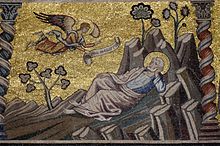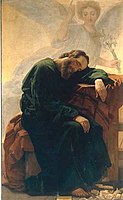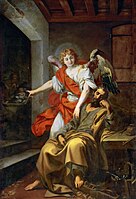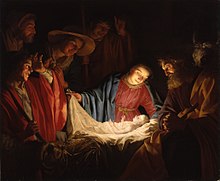
According to apocrypha, as well as Christian and Islamic tradition, Saint Anne was the mother of Mary, the wife of Joachim and the maternal grandmother of Jesus. Mary's mother is not named in the Bible's canonical gospels. In writing, Anne's name and that of her husband Joachim come only from New Testament apocrypha, of which the Gospel of James seems to be the earliest that mentions them. The mother of Mary is mentioned but not named in the Quran.

The virgin birth of Jesus is the Christian doctrine that Jesus was conceived by his mother, Mary, through the power of the Holy Spirit and without sexual intercourse. Christians regard the doctrine as an explanation of the mixture of the human and divine natures of Jesus. The Eastern Orthodox Churches accept the doctrine as authoritative by reason of its inclusion in the Nicene Creed, and the Catholic Church holds it authoritative for faith through the Apostles' Creed as well as the Nicene. Nevertheless, there are many contemporary churches in which it is considered orthodox to accept the virgin birth but not heretical to deny it.

Lorenzo Ghiberti, born Lorenzo di Bartolo, was an Italian Renaissance sculptor from Florence, a key figure in the Early Renaissance, best known as the creator of two sets of bronze doors of the Florence Baptistery, the later one called by Michelangelo the Gates of Paradise. Trained as a goldsmith and sculptor, he established an important workshop for sculpture in metal. His book of Commentarii contains important writing on art, as well as what may be the earliest surviving autobiography by any artist.

The nativity of Jesus, nativity of Christ, birth of Jesus or birth of Christ is described in the biblical gospels of Luke and Matthew. The two accounts agree that Jesus was born in Bethlehem, Judaea, that his mother, Mary, was engaged to a man named Joseph, who was descended from King David and was not his biological father, and that his birth was caused by divine intervention. Many modern scholars consider the birth narratives unhistorical because they are laced with theology and present two different accounts which cannot be harmonised into a single coherent narrative. However, many others view the discussion of historicity as secondary, given that gospels were primarily written as theological documents rather than chronological timelines.

The Annunciation, in greek, Ο Ευαγγελισμός της Θεοτόκου also referred to as the Annunciation to the Blessed Virgin Mary, the Annunciation of Our Lady, or the Annunciation of the Lord, is, according to the Gospel of Luke, the announcement by the archangel Gabriel to Mary that she would conceive and bear a son through a virgin birth and become the mother of Jesus Christ, the Christian Messiah and Son of God, marking the Incarnation. Gabriel told Mary to name her son Immanuel, meaning "God is with us".

The Adoration of the Magi or Adoration of the Kings or Visitation of the Wise Men is the name traditionally given to the subject in the Nativity of Jesus in art in which the three Magi, represented as kings, especially in the West, having found Jesus by following a star, lay before him gifts of gold, frankincense, and myrrh, and worship him. It is related in the Bible by Matthew 2:11: "On entering the house, they saw the child with Mary his mother; and they knelt down and paid him homage. Then, opening their treasure chests, they offered him gifts of gold, frankincense, and myrrh. And having been warned in a dream not to return to Herod, they left for their own country by another path".

The flight into Egypt is a story recounted in the Gospel of Matthew and in New Testament apocrypha. Soon after the visit by the Magi, an angel appeared to Joseph in a dream telling him to flee to Egypt with Mary and the infant Jesus since King Herod would seek the child to kill him. The episode is frequently shown in art, as the final episode of the Nativity of Jesus in art, and was a common component in cycles of the Life of the Virgin as well as the Life of Christ. Within the narrative tradition, iconic representation of the "Rest on the Flight into Egypt" developed after the 14th century.

The Holy Family consists of the Child Jesus, the Virgin Mary and Saint Joseph. The subject became popular in art from the 1490s on, but veneration of the Holy Family was formally begun in the 17th century by Saint François de Laval, the first bishop of New France, who founded a confraternity.

The Nativity of Jesus has been a major subject of Christian art since the 4th century.

The Life of the Virgin, showing narrative scenes from the life of Mary, the mother of Jesus, is a common subject for pictorial cycles in Christian art, often complementing, or forming part of, a cycle on the Life of Christ. In both cases the number of scenes shown varies greatly with the space available. Works may be in any medium: frescoed church walls and series of old master prints have many of the fullest cycles, but panel painting, stained glass, illuminated manuscripts, tapestries, stone sculptures and ivory carvings have many examples.
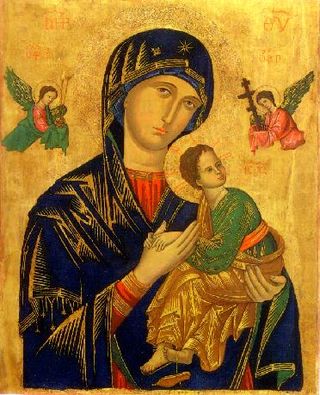
Mary has been one of the major subjects of Western Art for centuries. There is an enormous quantity of Marian art in the Catholic Church, covering both devotional subjects such as the Virgin and Child and a range of narrative subjects from the Life of the Virgin, often arranged in cycles. Most medieval painters, and from the Reformation to about 1800 most from Catholic countries, have produced works, including old masters such as Michelangelo and Botticelli.

The life of Christ as a narrative cycle in Christian art comprises a number of different subjects showing events from the life of Jesus on Earth. They are distinguished from the many other subjects in art showing the eternal life of Christ, such as Christ in Majesty, and also many types of portrait or devotional subjects without a narrative element.
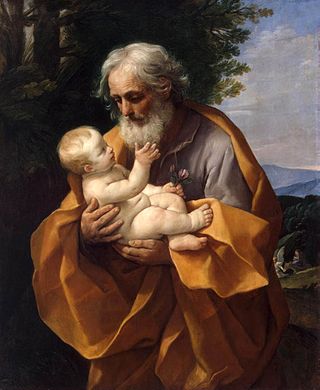
Joseph was a 1st-century Jewish man of Nazareth who, according to the canonical Gospels, was married to Mary, the mother of Jesus, and was the legal father of Jesus.

The annunciation to the shepherds is an episode in the Nativity of Jesus described in the Bible in Luke 2, in which angels tell a group of shepherds about the birth of Jesus. It is a common subject of Christian art and of Christmas carols.

The Adoration of the Shepherds is an oil-on-canvas painting by the Italian master Domenichino, executed c. 1607–1610. It has been in the National Gallery of Scotland in Edinburgh since 1971, and was previously in the Dulwich Picture Gallery in London.
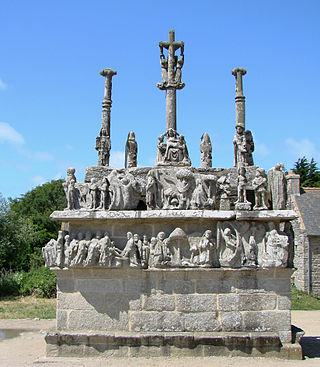
Calvary at Tronoën is a calvary located at Saint-Jean-Trolimon in the Quimper arrondissement. It is located in the "pays bigouden", a particularly wind swept area of Brittany; the nearby chapelle was called the "cathédrale des dunes".

Adoration of the Magi is an oil on panel painting from the early 1520s by the Dutch Renaissance artist Jan Mostaert in the collection of the Rijksmuseum, Amsterdam, where in 2020 it was on display in room 0.1. The panel measures 51 cm × 36.5 cm, and the painted surface a little less at 48.5 cm × 34 cm. It is often called the Mostaert Amsterdam Adoration in art history, to distinguish it from the multitude of other paintings of the Adoration of the Magi.

The Rest on the Flight into Egypt is a subject in Christian art showing Mary, Joseph, and the infant Jesus resting during their flight into Egypt. The Holy Family is normally shown in a landscape.

Joseph's Dream is a 1620s painting by Daniele Crespi, now in the Kunsthistorisches Museum in Vienna. It shows an angel appearing to Joseph of Nazareth in his sleep to warn him of Herod the Great's intent to kill Jesus and to instruct him to flee into Egypt. The subject depicts the second of Saint Joseph's four dreams as noted in the Gospel of Matthew.

The Mystical Nativity or Adoration in the Forest was painted by Fra Filippo Lippi around 1459 as the altarpiece for the Magi Chapel in the new Palazzo Medici in Florence. It is now in the Gemäldegalerie, Berlin, with a copy by another artist now hanging in the chapel. It is a highly individual depiction of the familiar scene of the Nativity of Jesus in art, placed in a mountainous forest setting, with debris from woodcutting all around, rather than the familiar stable in Bethlehem, and with the usual figures and animals around the mother and child replaced by others.
